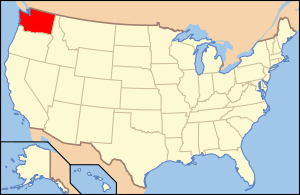Glines Canyon Dam
| Glines Canyon Dam | |
|---|---|
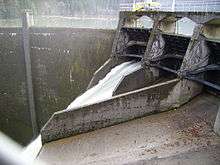 Glines Canyon Dam | |
| Location | Olympic National Park, Clallam County, Washington, USA |
| Construction began | 1925 |
| Opening date | 1927 |
| Demolition date | 2014 |
| Dam and spillways | |
| Impounds | Elwha River |
| Height | 210 ft (64 m) |
| Reservoir | |
| Creates | Lake Mills |
| Total capacity | 40,500 acre⋅ft (50,000,000 m3) |
| Surface area | 415 acres (168 ha) |
| Power Station | |
| Installed capacity | 13.3 MW[1] |
|
Glines Canyon Hydroelectric Power Plant | |
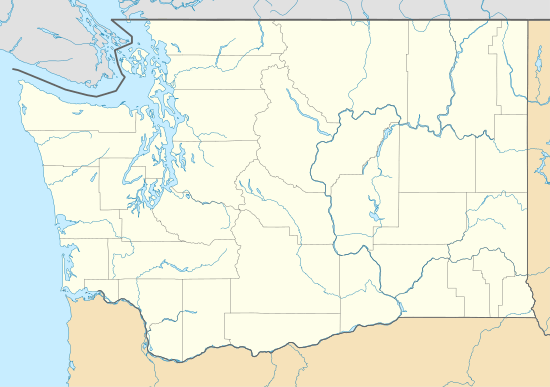 | |
| Location | On Elwha River, along Olympic Hot Springs Road, about 11 miles (18 km) southwest of Port Angeles, in Olympic National Park |
| Coordinates | 48°00′07″N 123°36′00″W / 48.00203°N 123.59991°WCoordinates: 48°00′07″N 123°36′00″W / 48.00203°N 123.59991°W |
| Area | 7 acres (2.8 ha) |
| Built | 1927 |
| Built by | Thebo, Starr, & Anderson Inc. |
| Architect | P.M. Thebo; W.B. McMillan; W.A. Whitmire; H.R. Stevens; H. Schorer |
| Architectural style | Other, Classical Revival, Neoclassical |
| MPS | Hydroelectric Power Plants in Washington State, 1890--1938 MPS |
| NRHP reference # | 88002742[2] |
| Added to NRHP | December 15, 1988 |
Glines Canyon Dam, also known as Upper Elwha Dam[3], built in 1927, was a 210-foot (64 m) high concrete arch dam built on the Elwha River within Olympic National Park, Clallam County, Washington.
It was located 13 miles (21 km) upstream from the mouth of the Elwha River at the Strait of Juan de Fuca, and about 8 miles upriver from the Elwha Dam. It impounded Lake Mills reservoir. The dam was demolished in 2014 as part of the Elwha River ecosystem restoration project; as of 2015 it is the tallest dam ever to be intentionally breached.
History
The dam was built privately to generate electricity for industries and major military installations on the Olympic Peninsula, including lumber and paper mills in Port Angeles.
The Glines Canyon Hydroelectric Power Plant historic district, a 7 acres (2.8 ha) area comprising the dam, the powerhouse, and the water conveying system, was listed on the National Register of Historic Places in 1988.[4]
Effects of dam on river habitat and area ecology
Lacking passage for migrating salmon, Glines Canyon Dam blocked access by anadromous salmonids[5] to the upper 38 miles (61 km) of mainstem habitat and more than 30 miles (48 km) of tributary habitat. The Elwha River watershed once supported salmon runs of more than 400,000 adult returns on more than 70 miles (110 km) of river habitat. By the early 21st-century, fewer than 4,000 adult salmon returned each year.
Habitat restoration
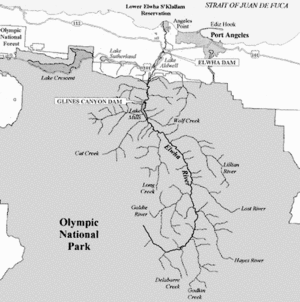
Numerous groups lobbied Congress to remove the two dams on the river and restore the habitat of the river and its valley. The Elwha River Ecosystem and Fisheries Restoration Act of 1992 authorized the US Federal Government to acquire the Elwha Dam and Glines Canyon Dam hydroelectric power projects for decommissioning and demolition for habitat restoration.
The Elwha Ecosystem Restoration project started in September 2011 as work to demolish the nearby Elwha Dam began downstream. The final piece of the Glines Canyon Dam was removed Aug. 26, 2014.[6] Now that the dam has been removed, the area that was under Lake Mills is being revegetated and its banks secured to prevent erosion and to speed up ecological restoration.
Gallery
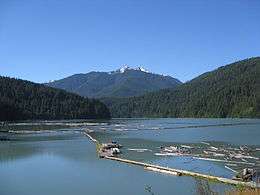

- Glines Canyon Dam (removed) from above, Oct 2014
- Glines Canyon Dam (removed) from inside reservoir, Oct 2014
See also
References
- ↑ "Restoring Rivers: Major upcoming dam removals in the Pacific Northwest" (PDF). www.water.ca.gov. Retrieved 21 June 2016.
- ↑ National Park Service (2010-07-09). "National Register Information System". National Register of Historic Places. National Park Service.
- ↑ U.S. Geological Survey Geographic Names Information System: Upper Elwha Dam
- ↑ "National Register of Historical Places record for Glines Canyon Hydroelectric Power Plant". Retrieved June 23, 2017. and accompanying pictures
- ↑ Grossman 2002, p. 155
- ↑ http://www.seattletimes.com/life/outdoors/olympic-parks-elwha-river-freed-after-last-dam-blasted-out/
Sources
- Grossman, Elizabeth (2002). Watershed: The Undamming of America, Basic Books, ISBN 1-58243-108-6.
- Mapes, Lynda V. (2016). "Elway: Roaring Back to Life," The Seattle Times. http://projects.seattletimes.com/2016/elwha/
External links
| Wikimedia Commons has media related to Glines Canyon Dam. |
- Glines Canyon Dam Removal Process - animation
- Glines Canyon Dam webcam and time lapse movie of removal project
- "Demolition dam: Why dismantle a huge river barrier?", BBC video
- Elwha River Restoration, National Park Service
- Mapes, Lynda V. (February 13, 2016), "Elwha: Roaring back to life", The Seattle Times

